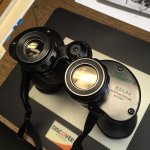Lots of clues, keep it coming

"I believe the use of prism screws started about 1985 with the introduction of Type 4a, or the 804R."
I thought it was about 20 years earlier.
So basically, the look of 1960's vs the look of 1980's styles.
And the names of new styles starting in the '80's
Does Swift have 2 eccentrics? Do they all use the same sort of fastening framework?
So having figured out one model, you are good for all models?
"They each had slightly different visual properties. But, of course, we will never know objectively how these coatings really differ to a
standard human observer since no one has elected to calculate any binoculars' luminosity, dominant wavelength, and excitation purity according to the
CIE Color Specification System.*"
That would be interesting. Who has that equipment? We could send examples for testing.
I wonder if the coatings degrade over the years.
How does fogging effect coated glass?
Any such age related changes could be estimated by using several samples of each model, or even each year of manufacture - graph a curve over time for similarly coated glass.






